The Dutch photographer Dick van Maarseveen (1905-1990) was in the 1930s famous for his star portraits and film stills. After the war, he concentrated on corporate photography, but Van Maarseveen also moved in the field of advertising and fashion photography. In his spare time, he did nude photography. A special section of his oeuvre are the pictures he made as a prisoner of war in camp Muhlberg during World War II.

Esther de Boer-van Rijk. Dutch postcard by M.B. & Z. (M. Bonnist & Zonen, Amsterdam). Photo: Dick van Maarseveen, Den Haag / M.H.D. Film. Publicity still for Op Hoop van Zegen (Alex Benno, Louis Saalborn, 1934). Collection Egbert Barten.
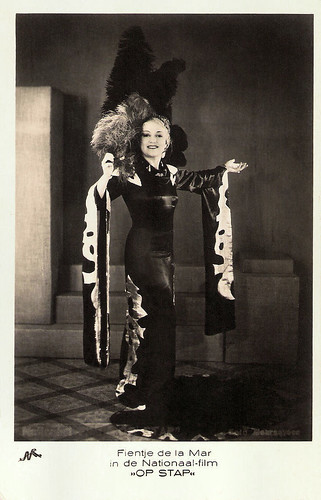
Fien(tje) de la Mar. Dutch postcard by M.B. & Z. (M. Bonnist & Zonen, Amsterdam). Photo: Dick van Maarseveen, Den Haag / Nationaal Film. Publicity still for Op stap/On the Move (Ernst Winar, 1935).
Dirk Willem Bastiaan (Dick) van Maarseveen was born in The Hague, The Netherlands, in 1905. In 1923 he went to work in the art trade firm of his parents as a list maker and seller of photo products. He got a slap IAG camera from his mother and started to photograph himself.
Moreover, he could take over a studio camera and some of the negative archives of photographer Adolphe Zimmermans, deceased in 1923. He got his first assignment by oil company Texaco.
In 1927, he moved into a studio on the Theresiastraat in The Hague, which he used especially for portrait photography. He worked as a photojournalist for the French magazine La Danse Theatre. Van Maarseveen won an honorable mention in 1930 on the anniversary exhibition of the Photographers Association of America and also won several awards in the following years.
In September 1931, Van Maarseveen moved to a new, luxury studio at the Bezuidenhout. Here he made a name as an artificial expert. He photographed many artists with whom he came into contact when he took care of the Amsterdam studio of portrait photographer Godfried de Groot during his holidays.
Rob van den Berg at ScherpteDiepte: "In the studio of Godfried de Groot, he developed technical skills in portraiture. There he met the international glamour portrait style, whose influence was visible in his work." Under the influence of the glamour photography that blew over the fashion and film industry, he always used back lighting, which strongly emerged the subject.
He produced photographs for the dance group of Darja Collin, who led a famous dance studio in The Hague. The quality of his pictures was so that many artists in the following years, preferred to be photographed by him.
Through his contacts with actors, he entered the film industry. After a cautious start in 1931, Van Maarseveen became the leading Dutch still photographer in the years 1933-1936. During the heyday of 'Hollands Hollywood’, he was the main still photographer.
Van Maarseveen was also engaged in advertising photography. Business was so good that Van Maarseveen had four staff members employed. These years formed a peak and almost simultaneously a conclusion of his most creative period.
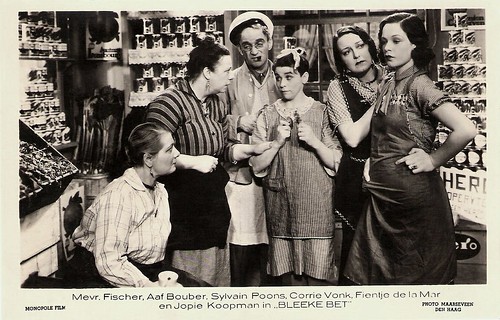
Dutch postcard by Monopole Film, Amsterdam. Photo: Maarseveen, Den Haag. Clara Vischer-Blaaser, Aaf Bouber, Sylvain Poons, Corry Vonk, Fien de la Mar and Jopie Koopman in the Dutch tragicomedy Bleeke Bet (Richard Oswald, Alex Benno, 1934).
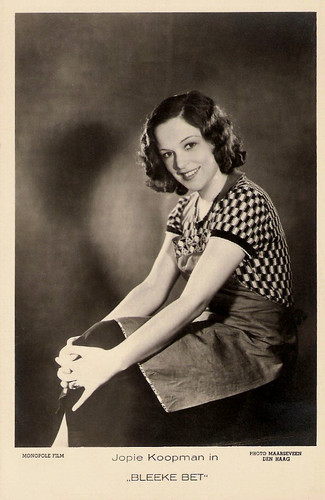
Jopie Koopman. Dutch postcard by Monopole Film, Rotterdam. Photo: Dick van Maarseveen. Still for Bleeke Bet (Alex Benno, Richard Oswald, 1934). Collection: Egbert Barten.
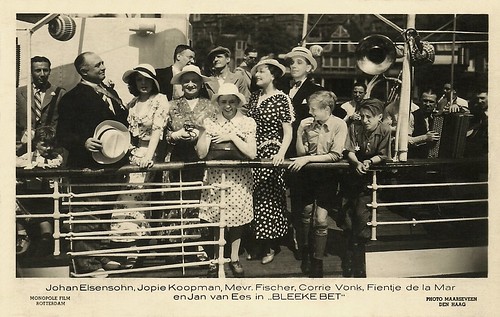
Dutch postcard by Monopole Film, Amsterdam. Photo: Maarseveen, Den Haag. Johan Elsensohn, Jopie Koopman, Clara Vischer-Blaaser, Corry Vonk, Fien de la Mar and Jan van Ees in the Dutch tragicomedy Bleeke Bet (Richard Oswald, Alex Benno, 1934).
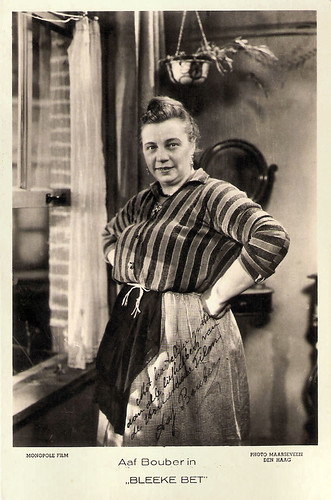
Aaf Bouber. Dutch postcard by M.B. & Z. (M. Bonnist & Zonen, Amsterdam). Photo: Dick van Maarseveen, Den Haag / Monopole Film. Publicity still for Bleeke Bet (Richard Oswald, Alex Benno, 1934). Collection: Egbert Barten.

Dutch Postcard by Monopole Film, Rotterdam. Photo: Dick van Maarseveen, Den Haag (The Hague). Publicity still for Bleeke Bet (Richard Oswald, Alex Benno, 1934).
Dick van Maarseveen worked on the set of such well-known Dutch films as Op stap/On the Move (Ernst Winar, 1935) starring Fien de la Mar, and Op hoop van zegen/The Good Hope (Alex Benno Louis Saalborn, 1934) with Esther de Boer van Rijk. He made popular portraits of these two stars. Van Maarseveen himself played a small supporting role in Op stap/On the Move (1935).
Van Maarseveen made more beautiful stills for films like Het mysterie van de Mondscheinsonate/The Mystery of the Moonlight Sonata (Kurt Gerron, 1935) and Rubber (Gerard Rutten, 1936). Van Maarseveen’s sharp image exposure was used gratefully for illuminating the set of the film Jonge harten/Young hearts (Charles Huguenot of Linden, 1936).
But the economic slump in portrait photography and a backlash in the film industry caused Van Maarseveen to take a big step back in 1937. He dismissed three of the four members of his staff, sold the studio furniture and moved to a smaller studio at the Bezuidenhout. He took a job as a consultant at Kodak. In 1938, Van Maarseveen married with A.J. Bergenhenegouwen.
In the summer of the next year, Van Maarseveen had to go into the army because of the mobilization. After the capitulation by the Netherlands on 15 May 1940, he was interned for several days as a prisoner, but then he could return to his film studio. He was still employed by Kodak.
In the film area Van Maarseveen’s ambitions reached beyond still photography. He wanted to be a cameraman. With his friend the artist Alfred Mazure, he made two short films, which stayed unfinished: De gasman/The gasman (Alfred Mazure, 1942) and Vals geld/Counterfeit (Alfred Mazure, 1942) both with Maurice van Nieuwenhuizen as Dick Bos. He also made two enthusiastically received ‘job films' for Schoevers Institute in The Hague.
The stricter control of the Germans on the Dutch film industry blocked for Van Maarseveen a career in this field. On 29 April 1943, the German occupiers decided to take all Dutch soldiers from May 1940 in captivity. Van Maarseveen was deported to Germany.
He spent the bulk of his time in Mühlberg on the Elbe. His camp, Stalag IVB, was a model camp where the Germans wanted to show the world how well they treated their prisoners of war. In June 1944, after about a year of camp life, he could work as a photographer for the camp. Along with some other prisoners, including his Dutch colleague Cor van Weele, Van Maarseveen was instructed to photograph all kinds of official events in the camp, such as religious activities, theater evenings and sport and to make passport photos of the new arrivals. He also made clandestine photos.
Mühlberg camp was liberated by the Russians on 23 April 1945. Maarseveen brought photographs and glass negatives back home. In The Hague, his studio at the Bezuidenhout was in a section of the street that passed the war, but it was ‘purged’ during the bombardment of March 1945, leaving his archive partially lost.
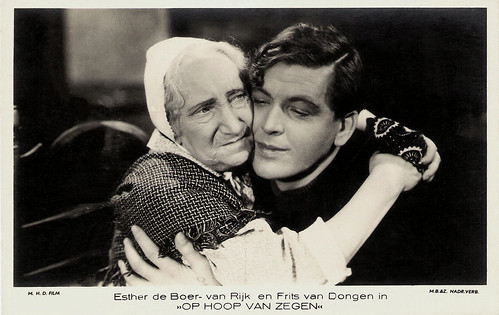
Esther de Boer-van Rijk and Frits van Dongen (Philip Dorn). Dutch postcard by M.B. & Z / M.H.D. Film. Photo: Maarseveen, Den Haag. Publicity still for Op hoop van zegen/The Good Hope (Alex Benno, 1934).
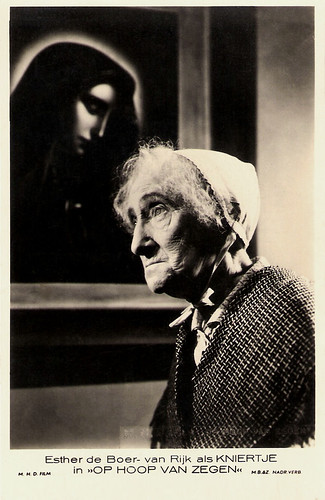
Esther de Boer-van Rijk. Dutch postcard by M.B. & Z / M.H.D. Film. Photo: Maarseveen, Den Haag. Publicity still for Op hoop van zegen/The Good Hope (Alex Benno, 1934).

Jan van Ees and Esther de Boer-van Rijk. Dutch postcard by M.B. & Z. (M. Bonnist & Zonen, Amsterdam). Photo: Dick van Maarseveen, Den Haag/M.H.D. Film. Publicity still for Op Hoop van Zegen (1934, Alex Benno, Louis Saalborn). Collection Egbert Barten.

Esther de Boer-van Rijk. Dutch postcard by M.B. & Z / M.H.D. Film. Photo: Maarseveen, Den Haag. Publicity still for Op hoop van zegen/The Good Hope (Alex Benno, 1934). Collection: Egbert Barten.

Dutch postcard by M.B. & Z. (M. Bonnist & Zonen, Amsterdam). Photo: Dick van Maarseveen, Den Haag/M.H.D. Film. Publicity still for Op Hoop van Zegen (Alex Benno, Louis Saalborn, 1934) with Esther de Boer-van Rijk, Coen Hissink and Willem v.d. Veer. Collection Egbert Barten.
Dick van Maarseveen rebuilt his heavily damaged studio. After several years in which he gave the artistic portrait photography much attention, he concentrated largely on freelance work for industry and advertising. Already in 1925, he had laid contact with Texaco (from about 1947 to 1967 along with Chevron united in the operating company Caltex) which lead to a lengthy contract.
He worked part time for Kodak in London, where he learned to deal basically with color photography according to the new Ektachrome. He then spread the knowledge through courses in the Netherlands. In 1950, Van Maarseveen assisted British photographer Cecil Beaton, who was commissioned by Vogue magazine to portray the Dutch royal family.
In 1950s and 1960s he photographed 'herrijzend Nederland’ (resurgent Netherlands) and especially for Texaco he was regularly on the road. His activities ranged from making passport photos to 'stunt work' on oil rigs and high cranes in ports. Thanks to good relations in several church boards, he also photographed a number of interiors of churches.
In the 1960s, he was a board member of the Foundation Fotovakschool which emerged in the School of Photography and Photo Technology in The Hague and he was regularly in the examination committee. The oil crisis in 1973 made an end to his work for Texaco, but Van Maarseveen continued to work as a freelance photographer until 1978.
In 1978 he brought his collection of film stills under at the Dutch Filmmuseum in Amsterdam (now Eye Institute). In 1980, Van Maarseveen sold a part of his archive – his portraits, nudes and corporate photography - at the Prentenkabinet of the Rijksuniversiteit Leiden (Print Room of the University of Leiden). After an interview in 1982, his photographs from the camp period were rediscovered and housed at the Rijksmuseum in Amsterdam.
In 1990, Dick van Maarseveen died in his hometown Rijssen in the Netherlands.
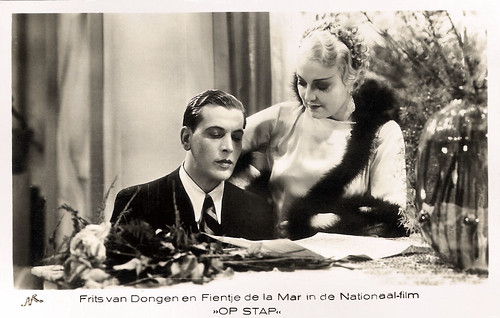
Frits van Dongen and Fien de la Mar. Dutch postcard by M.B. & Z. (M. Bonnist & Zonen, Amsterdam). Photo: Dick van Maarseveen, Den Haag / Nationaal Film. Publicity still for Op stap/On the Move (Ernst Winar, 1935).

Johan Elsensohn. Dutch postcard by M.B. & Z. (M. Bonnist & Zonen, Amsterdam). Photo: Dick van Maarseveen, Den Haag/Monopole Film. Publicity still for Bleeke Bet (Richard Oswald, Alex Benno, 1934). Collection: Egbert Barten.

Hansje Andriesen. Dutch postcard by Monopole Film N.V. Photo: Dick van Maarseveen. Still for De Big van het Regiment (Max Nosseck, 1935). Collection: Egbert Barten.
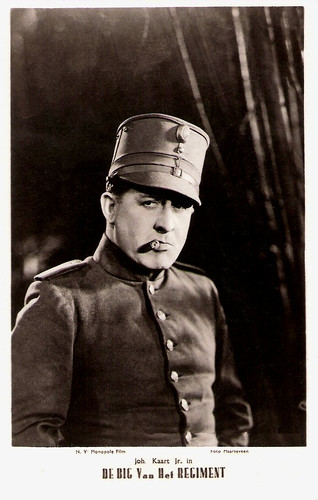
Johan Kaart. Dutch postcard by Monopole Film N.V. Photo: Dick van Maarseveen. Still for De Big van het Regiment (Max Nosseck, 1935). Collection: Egbert Barten.
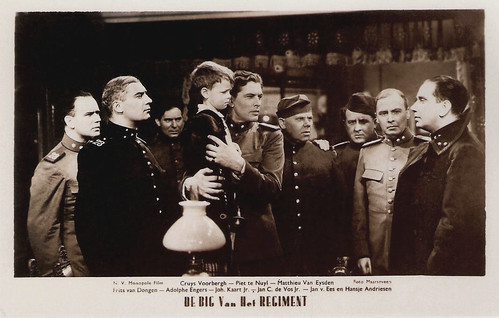
Dutch postcard by Monopole Film NV. Photo: Dick van Maarseveen. Still for De Big van het Regiment (Max Nosseck, 1935). Collection: Egbert Barten.
Check out our other posts on film star photographers. See the links at right under the caption 'The Photographers'.
Sources: Rob van den Berg (ScherpteDiepte - Dutch), Rijksmuseum (Dutch), Eye, RKD, Fotografen.nl and IMDb.

Esther de Boer-van Rijk. Dutch postcard by M.B. & Z. (M. Bonnist & Zonen, Amsterdam). Photo: Dick van Maarseveen, Den Haag / M.H.D. Film. Publicity still for Op Hoop van Zegen (Alex Benno, Louis Saalborn, 1934). Collection Egbert Barten.

Fien(tje) de la Mar. Dutch postcard by M.B. & Z. (M. Bonnist & Zonen, Amsterdam). Photo: Dick van Maarseveen, Den Haag / Nationaal Film. Publicity still for Op stap/On the Move (Ernst Winar, 1935).
The international glamour portrait style
Dirk Willem Bastiaan (Dick) van Maarseveen was born in The Hague, The Netherlands, in 1905. In 1923 he went to work in the art trade firm of his parents as a list maker and seller of photo products. He got a slap IAG camera from his mother and started to photograph himself.
Moreover, he could take over a studio camera and some of the negative archives of photographer Adolphe Zimmermans, deceased in 1923. He got his first assignment by oil company Texaco.
In 1927, he moved into a studio on the Theresiastraat in The Hague, which he used especially for portrait photography. He worked as a photojournalist for the French magazine La Danse Theatre. Van Maarseveen won an honorable mention in 1930 on the anniversary exhibition of the Photographers Association of America and also won several awards in the following years.
In September 1931, Van Maarseveen moved to a new, luxury studio at the Bezuidenhout. Here he made a name as an artificial expert. He photographed many artists with whom he came into contact when he took care of the Amsterdam studio of portrait photographer Godfried de Groot during his holidays.
Rob van den Berg at ScherpteDiepte: "In the studio of Godfried de Groot, he developed technical skills in portraiture. There he met the international glamour portrait style, whose influence was visible in his work." Under the influence of the glamour photography that blew over the fashion and film industry, he always used back lighting, which strongly emerged the subject.
He produced photographs for the dance group of Darja Collin, who led a famous dance studio in The Hague. The quality of his pictures was so that many artists in the following years, preferred to be photographed by him.
Through his contacts with actors, he entered the film industry. After a cautious start in 1931, Van Maarseveen became the leading Dutch still photographer in the years 1933-1936. During the heyday of 'Hollands Hollywood’, he was the main still photographer.
Van Maarseveen was also engaged in advertising photography. Business was so good that Van Maarseveen had four staff members employed. These years formed a peak and almost simultaneously a conclusion of his most creative period.

Dutch postcard by Monopole Film, Amsterdam. Photo: Maarseveen, Den Haag. Clara Vischer-Blaaser, Aaf Bouber, Sylvain Poons, Corry Vonk, Fien de la Mar and Jopie Koopman in the Dutch tragicomedy Bleeke Bet (Richard Oswald, Alex Benno, 1934).

Jopie Koopman. Dutch postcard by Monopole Film, Rotterdam. Photo: Dick van Maarseveen. Still for Bleeke Bet (Alex Benno, Richard Oswald, 1934). Collection: Egbert Barten.

Dutch postcard by Monopole Film, Amsterdam. Photo: Maarseveen, Den Haag. Johan Elsensohn, Jopie Koopman, Clara Vischer-Blaaser, Corry Vonk, Fien de la Mar and Jan van Ees in the Dutch tragicomedy Bleeke Bet (Richard Oswald, Alex Benno, 1934).

Aaf Bouber. Dutch postcard by M.B. & Z. (M. Bonnist & Zonen, Amsterdam). Photo: Dick van Maarseveen, Den Haag / Monopole Film. Publicity still for Bleeke Bet (Richard Oswald, Alex Benno, 1934). Collection: Egbert Barten.

Dutch Postcard by Monopole Film, Rotterdam. Photo: Dick van Maarseveen, Den Haag (The Hague). Publicity still for Bleeke Bet (Richard Oswald, Alex Benno, 1934).
A big step back
Dick van Maarseveen worked on the set of such well-known Dutch films as Op stap/On the Move (Ernst Winar, 1935) starring Fien de la Mar, and Op hoop van zegen/The Good Hope (Alex Benno Louis Saalborn, 1934) with Esther de Boer van Rijk. He made popular portraits of these two stars. Van Maarseveen himself played a small supporting role in Op stap/On the Move (1935).
Van Maarseveen made more beautiful stills for films like Het mysterie van de Mondscheinsonate/The Mystery of the Moonlight Sonata (Kurt Gerron, 1935) and Rubber (Gerard Rutten, 1936). Van Maarseveen’s sharp image exposure was used gratefully for illuminating the set of the film Jonge harten/Young hearts (Charles Huguenot of Linden, 1936).
But the economic slump in portrait photography and a backlash in the film industry caused Van Maarseveen to take a big step back in 1937. He dismissed three of the four members of his staff, sold the studio furniture and moved to a smaller studio at the Bezuidenhout. He took a job as a consultant at Kodak. In 1938, Van Maarseveen married with A.J. Bergenhenegouwen.
In the summer of the next year, Van Maarseveen had to go into the army because of the mobilization. After the capitulation by the Netherlands on 15 May 1940, he was interned for several days as a prisoner, but then he could return to his film studio. He was still employed by Kodak.
In the film area Van Maarseveen’s ambitions reached beyond still photography. He wanted to be a cameraman. With his friend the artist Alfred Mazure, he made two short films, which stayed unfinished: De gasman/The gasman (Alfred Mazure, 1942) and Vals geld/Counterfeit (Alfred Mazure, 1942) both with Maurice van Nieuwenhuizen as Dick Bos. He also made two enthusiastically received ‘job films' for Schoevers Institute in The Hague.
The stricter control of the Germans on the Dutch film industry blocked for Van Maarseveen a career in this field. On 29 April 1943, the German occupiers decided to take all Dutch soldiers from May 1940 in captivity. Van Maarseveen was deported to Germany.
He spent the bulk of his time in Mühlberg on the Elbe. His camp, Stalag IVB, was a model camp where the Germans wanted to show the world how well they treated their prisoners of war. In June 1944, after about a year of camp life, he could work as a photographer for the camp. Along with some other prisoners, including his Dutch colleague Cor van Weele, Van Maarseveen was instructed to photograph all kinds of official events in the camp, such as religious activities, theater evenings and sport and to make passport photos of the new arrivals. He also made clandestine photos.
Mühlberg camp was liberated by the Russians on 23 April 1945. Maarseveen brought photographs and glass negatives back home. In The Hague, his studio at the Bezuidenhout was in a section of the street that passed the war, but it was ‘purged’ during the bombardment of March 1945, leaving his archive partially lost.

Esther de Boer-van Rijk and Frits van Dongen (Philip Dorn). Dutch postcard by M.B. & Z / M.H.D. Film. Photo: Maarseveen, Den Haag. Publicity still for Op hoop van zegen/The Good Hope (Alex Benno, 1934).

Esther de Boer-van Rijk. Dutch postcard by M.B. & Z / M.H.D. Film. Photo: Maarseveen, Den Haag. Publicity still for Op hoop van zegen/The Good Hope (Alex Benno, 1934).

Jan van Ees and Esther de Boer-van Rijk. Dutch postcard by M.B. & Z. (M. Bonnist & Zonen, Amsterdam). Photo: Dick van Maarseveen, Den Haag/M.H.D. Film. Publicity still for Op Hoop van Zegen (1934, Alex Benno, Louis Saalborn). Collection Egbert Barten.

Esther de Boer-van Rijk. Dutch postcard by M.B. & Z / M.H.D. Film. Photo: Maarseveen, Den Haag. Publicity still for Op hoop van zegen/The Good Hope (Alex Benno, 1934). Collection: Egbert Barten.

Dutch postcard by M.B. & Z. (M. Bonnist & Zonen, Amsterdam). Photo: Dick van Maarseveen, Den Haag/M.H.D. Film. Publicity still for Op Hoop van Zegen (Alex Benno, Louis Saalborn, 1934) with Esther de Boer-van Rijk, Coen Hissink and Willem v.d. Veer. Collection Egbert Barten.
Cecil Beaton
Dick van Maarseveen rebuilt his heavily damaged studio. After several years in which he gave the artistic portrait photography much attention, he concentrated largely on freelance work for industry and advertising. Already in 1925, he had laid contact with Texaco (from about 1947 to 1967 along with Chevron united in the operating company Caltex) which lead to a lengthy contract.
He worked part time for Kodak in London, where he learned to deal basically with color photography according to the new Ektachrome. He then spread the knowledge through courses in the Netherlands. In 1950, Van Maarseveen assisted British photographer Cecil Beaton, who was commissioned by Vogue magazine to portray the Dutch royal family.
In 1950s and 1960s he photographed 'herrijzend Nederland’ (resurgent Netherlands) and especially for Texaco he was regularly on the road. His activities ranged from making passport photos to 'stunt work' on oil rigs and high cranes in ports. Thanks to good relations in several church boards, he also photographed a number of interiors of churches.
In the 1960s, he was a board member of the Foundation Fotovakschool which emerged in the School of Photography and Photo Technology in The Hague and he was regularly in the examination committee. The oil crisis in 1973 made an end to his work for Texaco, but Van Maarseveen continued to work as a freelance photographer until 1978.
In 1978 he brought his collection of film stills under at the Dutch Filmmuseum in Amsterdam (now Eye Institute). In 1980, Van Maarseveen sold a part of his archive – his portraits, nudes and corporate photography - at the Prentenkabinet of the Rijksuniversiteit Leiden (Print Room of the University of Leiden). After an interview in 1982, his photographs from the camp period were rediscovered and housed at the Rijksmuseum in Amsterdam.
In 1990, Dick van Maarseveen died in his hometown Rijssen in the Netherlands.

Frits van Dongen and Fien de la Mar. Dutch postcard by M.B. & Z. (M. Bonnist & Zonen, Amsterdam). Photo: Dick van Maarseveen, Den Haag / Nationaal Film. Publicity still for Op stap/On the Move (Ernst Winar, 1935).

Johan Elsensohn. Dutch postcard by M.B. & Z. (M. Bonnist & Zonen, Amsterdam). Photo: Dick van Maarseveen, Den Haag/Monopole Film. Publicity still for Bleeke Bet (Richard Oswald, Alex Benno, 1934). Collection: Egbert Barten.

Hansje Andriesen. Dutch postcard by Monopole Film N.V. Photo: Dick van Maarseveen. Still for De Big van het Regiment (Max Nosseck, 1935). Collection: Egbert Barten.

Johan Kaart. Dutch postcard by Monopole Film N.V. Photo: Dick van Maarseveen. Still for De Big van het Regiment (Max Nosseck, 1935). Collection: Egbert Barten.

Dutch postcard by Monopole Film NV. Photo: Dick van Maarseveen. Still for De Big van het Regiment (Max Nosseck, 1935). Collection: Egbert Barten.
Check out our other posts on film star photographers. See the links at right under the caption 'The Photographers'.
Sources: Rob van den Berg (ScherpteDiepte - Dutch), Rijksmuseum (Dutch), Eye, RKD, Fotografen.nl and IMDb.
No comments:
Post a Comment